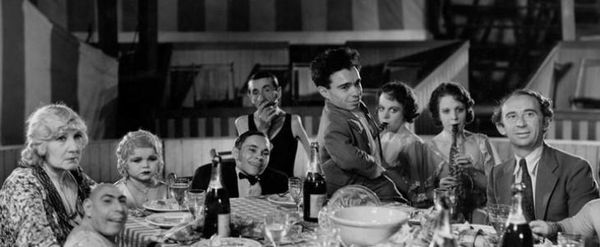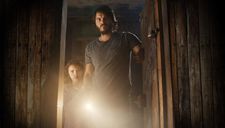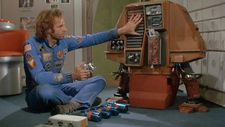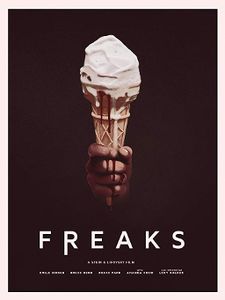 |
| "It’s in a science fiction world that mirrors our own but it’s really about this family" - Adam B Stein |
In part one of my interview with Zach Lipovsky and Adam B Stein about Freaks, which recently screened at the Fantasia International Film Festival, we talked about the challenges of making a film that would really keep audiences guessing, and about the amazing lead performance they coaxed out of then eight-year-old Lexy Kolker. In part two we started by discussing how Zach’s own past as a child star helped him to work with Lexy, and has helped him with actors more generally.
“It’s really helpful if you know what it’s like to be in front of the camera, and the pressures of being in front of the camera,” he says. “From behind the camera it looks really easy because you just have to tell them what to do and stuff, and you forget what it’s like to have all the lights and all the cameras and everyone’s attention on you. And the insecurity that comes with that. Also a lot of it is, like, how to keep the actors comfortable and confident. If you’re going to do another take because the camera went out of focus. you don’t just say ‘Okay, let’s do it again.’ because the actors will think that they sucked. So you say ‘Oh sorry, the camera had an issue, we’re going to go again, but you were great!’ So then they still have the confidence to do good work.”
 |
| Lexy Kolker and Emile Hirsch in Freaks |
“You get them to be relaxed and not be thinking about their own performance,” says Adam. “You can’t give a good performance if you’re judging yourself while you’re doing it. With Lexy we also did all sorts of things to help her feel more comfortable. For instance, when she first came to the house where we were filming we had her go through the rooms while they were still decorating it and do a bunch of the drawings that were put on the walls to make it her own and really start to feel at home there.”
Then there’s the return of Bruce Dern to science fiction, something that has really got people talking.
“Casting is one of the hardest parts of making a movie when you don’t have a lot of money,” says Zach. “You have to kind of send the script out into the universe and it’s very frustrating. You send out a script and then you wait a bunch of time and you don’t know if they ever read it or not, and then you send it to somebody else. And Bruce was someone we sent it to that got back to us right away and he was the first big actor that read the script and liked it and wanted to be a part of it, and that was really exciting for us.”
“As you said, he hasn’t done science fiction in – I think it’s 45 years,” adds Adam. “Since 1972. He had sort of a bias against science fiction that I think is not accurate, but...” He shrugs. “He told us ‘Science fiction’s bullshit! I wanna play real people. I don’t wanna play robots and aliens!’”
I compliment him on what is a pretty good impression of the veteran actor’s voice and mannerisms.
 |
| Bruce Dern talks to a robot in Silent Running in 1972 |
Adam laughs, and continues “...but he saw that what we were trying to do with the film was about family. It’s in a science fiction world that mirrors our own but it’s really about this family and he, I think, really connected to the idea of saving his daughter. The feeling of ‘No matter what, I’m going to save my daughter and no-one’s going to stop me.’ And that’s what he sunk his teeth into and what kept him going through everything.”
So how did they approach telling such a big story with small sets and a very small budget?
“When we wrote the script the plan was to make it for zero dollars,” says Zach. “That was actually with Adam and I starring in it, and Adam’s son. We wanted to make a movie that we could make no matter what. Whatever amount of money we ever got, we could make it. So we wanted to make sure that using just the resources that we had, which at the time was a kid and a house and a restaurant, that we could tell the story we needed to, and then all of the concepts that we came up with and all of the scope that we wanted to put in the movie were all things that we basically knew we could do in a way that would hint at a bigger world but could be done very easily but still feel real and authentic. Like all of the different visual elements in the movie, without giving anything away, were all designed to be quite photographic in nature so that there weren’t any giant CG creatures or giant CG environments. It was all stuff that looked like it has just been photographed.”
 |
| Freaks poster |
“There was never any studio behind this movie,” says Adam. “It originally started with inspiration from the Duplass brothers. We saw a speech where they were talking about how they made Puffy Chair, which was their first feature, and basically saying ‘Make a list of what you have’ – and in their case they had a puffy chair and a van – and they said ‘Let’s make a movie about that.’ So, we are sci-fi fans and we’re like okay, what kind of sci-fi film could we tell the story of if we have no money? And that’s where the original conversations about the story started. We really tried to keep to that strategy even when we started getting a little bit of investment here and there. We never had very much and we always said ‘So we have $20,000. Right. So we’ll make the movie for $20,000.’ We never wanted to be in a position where w suddenly said ‘Okay, we need two million dollars and we don’t have two million dollars. We just said ‘We’re going to try to make this movie with whatever resources we have.’ And we had to be clever about things like visual effects.”
The film has been making quite an impression at festivals. What are their ambitions for it now?
“We’re actually just coming to the end of us run on the festival circuit. We play at Frightfest in London and that’s the last festival,” says Zach. “That weekend [23 August] is also the theatrical release of the movie in the US. And then it’s going to be playing in Canada on September 20th. Each country it’ll be coming out in a different form: some theatre, some on home video, and so on. So the exciting part is, we’ve toured the whole world with the film and it’s been amazing to see audiences all over the world enjoy it, and now it’s going to be available to the public.”
“This was a very, very personal movie for use,” says Adam. “Like Zach said, partly inspired by my son and my experience with fatherhood.” Seeing people enjoy and connect with it is, he says, a wonderful experience.





















